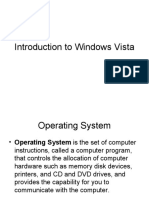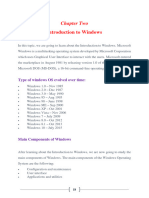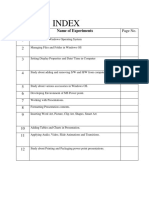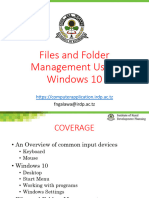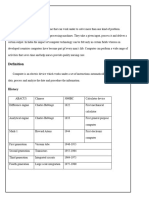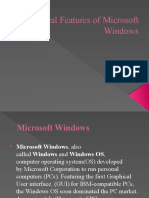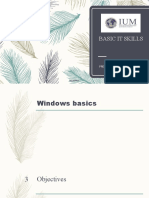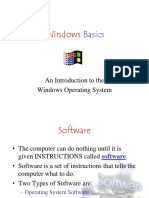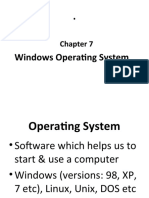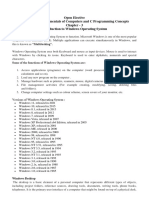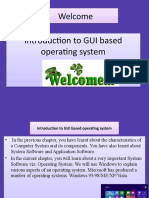0 ratings0% found this document useful (0 votes)
778 views23 pagesClass 9 Computer Chapter 8
Uploaded by
Liam NoahCopyright
© © All Rights Reserved
We take content rights seriously. If you suspect this is your content, claim it here.
Available Formats
Download as PDF or read online on Scribd
0 ratings0% found this document useful (0 votes)
778 views23 pagesClass 9 Computer Chapter 8
Uploaded by
Liam NoahCopyright
© © All Rights Reserved
We take content rights seriously. If you suspect this is your content, claim it here.
Available Formats
Download as PDF or read online on Scribd
You are on page 1/ 23
Chapter 8 128 Computer 9
‘Chapter
A
Introduction to Windows
Microsoft windows is a family of operating systems for personal computers.
Windows dominates the personal computer world, running almost on 90% of all personal
computers, The remaining 10% are mostly Macintosh computers and LINUX operating
system based machines, Windows provides a graphical user interface (GUD, virtual memory
management, multitasking, and support for many peripheral devices. This chapter will show
you all the basics you need to get started. You'll get an overview of Windows features, and
{you'll eam how to use Help to get an answer to your questions and find out more about using
windows operating systems.
8.1 Main Keywords Associated With Microsoft Windows
« Disk Drives
Drives are devices used to store data. Most computers have atleast two drives: a hard
drive CA (Which is the main means of storage) and a floppy drive (which stores
smaller volumes of data (1.44 Mb) on 3.5 disks - floppy disks). The hard drive is
typically designated the C:\ drive and the floppy drive is typically designated the Ad
drive. If you have an additional floppy drive, itis typically designated the B:\ drive.
‘A hard disk can have multiple partitions as well In that case the first partition will be
labeled as C:\ and the rest will be labeled as D:\, E:\and so on depending, upon the
number of partitions. You can also have network drives on your computer, depending
‘on authorization and rights of eachuser. These drives will typically be labeled after the
hard drives, e.g. H:\or GA
¢ Folders (Directory)
Folders are used to organize the data stored on your drives. Think of your computer
drives as filing cabinets, You can sort your data on drives with folders that store
“ifferent files. ‘The files that make up a program are stored together in their own set
of folders. You can organize the files you create in folders lor better accessibility,
Folders can be copied and moved from one place to another on your hard disk.
¢ File Extensions
File Extensions are the ending letters which are placed after a DOT in the file name
eg. PhoneNumbers.tx. In this file name, PhoneNumbers is the name of the file and
faris the file extension, This extension of a file associates it with an application that
cca be used to view and manipulate it. In this way Windows knows which program (0
open for a particular file type. For example, a text file has an extension of Ot, so a
text file created in Notepad with the name PhoneNumbers would look like this
PhoneNumbers.txt, You do not have to assign a file extension to a file that you
create, The program you use will automatically do this for you. All you need to do is,
give it a filename. Some other common extensions are as Follows:
«doc = Microsoft Word Document
NOT FOR SALE - PESRP.
Chapter 8 129 Computer 9
eee
. Microsoft Excel Document
* .ppt= Microsoft PowerPoint Presentation
‘© mdb = Microsoft Access Database
© bmp = Windows Bitmap Picture
© way = Sound File
© chum of htm = hypertext document
Icon
An Icon is a graphic image. Icons help you execute commands quickly. Commands
tell the computer what you want the computer to do, These may be shortcuts 10
applications which are installed on your computer. If you want o exeeute a command
by using an icon, double-click on it. Below are some of the icons and their uses.
My Computer ‘ ‘My Computer icon provides access to the different paris on |
BS your computer. You can access the different disk drives
2 (Hard Drive, Floppy Drive, and Network Drives) inside My
Computer.
Recycle Bin ‘When you delete a file or folder, Windows sends it to the
= Recycle Bin. You can restore the file or folder that are
re located in the Recycle Bin or you can permanently delete
them by right clicking on the Recycle Bin and select Empry
Reeyele Bin,
‘My Documents ‘The My Documents folder is nothing more than a regular
offers an easy-to-teach location where you can store and
retrieve important data, and the icon is always available in,
Explorer Windows and on the desktop.
= folder that resides on your Windows Desktop, However, it
Taternet The Internet Explorer icon launches the Internet Explorer
Explorer © | browses. The tmternet Explorer browser js whit you wil
use to access the iniernet and the World Wide Web.
8.2 Features of Windows
Graphical User Interface:
Windows provide user-friendly. interface to work. Its improved graphical user
interface makes learning and using Windows more natural and easiet for all types of
users, Itis more stable, customizable and efficient
Start Button
Introduction of START button in Windows made life much simpler while there is a
need {o access multiple programs. It is the gateway of accessing most of the
functionality available in the computer loaded with Windows. Just Click on the Start
bution anytime to start any programs, open or find documents, change windows
settings, get Help, manage Files, maintain system, and much more.
Taskbar
As the name suggests, the Task bar provides information and access to applications
that are being currently run by Windows, Using this, one can keep track of programs
that have been activated! and can switch between them.
NOT FOR SALE -PESRP
Chapter 8 130 Computer 9
Windows Explorer :
Windows Explorer acts as a directory browser and File Manager for Windows, and
incorporates lots of additional features. It is an efficient, faster and user friendly way
for locating and managing files on your computer.
Using Explorer one can easily browse through all the drives and network resources
available and manage them.
Mouse
Although you can use the keyboard for most actions, many of these actions are easier
to perform with a mouse. The mouse controls a pointer on the screen. You move the
pointer by sliding the mouse over a flat surface in the direction you want the pointer
to move. If you run out of room to move the mouse, lift it up and then put it down in
amore comfortable location, Mentioned below are the five basic mouse actions.
‘© Point to an item: Move the mouse to place the pointer on the item.
* Click an item: Point to the item on your screen, and then quickly press and
release the left mouse button.
+ Rightlick an items Point to the item on your sree, and then quickly press
and release the right mouse button. Clicking the right mouse button displays a
Shortcut menu from which you can choose from a list of commands that apply to
that item.
‘© Double-click an item: Point to the item, and then quickly press and release the
left mouse button twice.
‘* Drag an item: Point to an item, and then hold down the left mouse bution as you
‘move the pointer.
Shortcuts
[As the name suggests, SHORTCUTS establish a link with original programs, these
are the shortest way of accessing files and other resources in Windows. Instead of.
iraversing the fall path of the program to access it, one can create “shortcuts” -
Multitasking
“Multitasking allows the user to activate and accomplish more than one task at a time.
For example, work on a document file in WORD programs, while copying file from
other computer available on the network, With Windows computing environment, the
user can do more than one task at a time.
Easy Internet Access
One of the most useful and entirely new features in Windows is easy access to
Internet. It provides built-in Internet functionality to setup link and access Internet
with fewer amounts of Hardware and Software requirement. It also provides
connectivity software from Microsoft Network (MSN) which allows you to stay in
touch with family and friends throughout the world.
It also improves the efficiency of working on Internet with applications that support
the latest Internet technologies, such as Internet Explorer, Java, and streaming audio
‘and video support
Great Gaming Platform
Windows support rich graphies, high quality audio and video, It has all the
functionality incorporated in it to support these technologies. All this is possible
because of Windows compatibility with latest and hottest technologies like Plug and
Play, AutoPlay, and built-in support for MIDI and digital audio and video.
NOT FOR SALE -PESRP
Computer 9
Chapter 8 131
—. $$
© Hardware Compatibility
83
Windows provides greater Hardware compatibility as compare to any other operating
environment. It has flexibility of supporting hardware irom different vendors, Its
Plug and Play functionality allows you to insert the hardware card into the computer
and when the computer is tumed on Windows automatically recognizes and sets up
the hardware,
Search Utility
Search Utility of Windows allows you to do searches by partial name, last modified
date, or full text. In addition, you can save, rename, or view files from within the
result pane, just like you can from Windows Explorer.
Help
Windows provides online help to accomplish a task. If the user is not sure how to
perform a task, Windows Help will provide structured process for guiding on how to
‘accomplish the task. Simply right-click on any object in the user interface (icons) and
you'll get relevant descriptions about that object. Help can also be accessed from the
Start menu button,
Windows Desktop
‘When you start your computer, the desktop is the first thing you sce after logging into
the computer, For login you have to give username and password. A common desktop image
shown in Fig.8.1, which shows the screen with icons for various programs. The desktop is the
area where you work.
Stott
Applications running
on the computer
Figure 8.1: Windows Desktop
NOT FOR SALE - PESRP
Chapter 8 132 Computer 9
Chapter
8.3.1. Start Button and Taskbar
Windows features the Start button and Taskbar at the bottom of the screen. This
‘bar contains the Start button. Using this button, a program can be quickly started or file
cea be searched for. Quick help on how to use windows can also be obtained from this task
bar.
eee
Figure 8.2: Start meno.
Click on the Start to activate the Pop-up menu, click on All Programs to run
applications, use Search button to find a file or folders (directory or sub-directory), Help and
Support button to change the settings for Windows, Run a program using the Rup link or shut
down the computer using the Shur Down bution at the bottom of the menu,
IF you haye opened more than one program or windows, you can switeh between
them, All the opened windows or program appears on the Task bar as minimized icons as
shown in figure 8.1. Click on the desired icon to open the designated program. Similarly if
you don't need a window too frequently, click on the minimized button of the widows. This
‘will send the activated window as small icon to the task bar.
8.3.2 Steps to start a program
a 1. Click on the Start button, and then point to All Programs option,
2. Select the program you want to run. If the program you want is not on the
‘menu, point to the folder that contains the program.
3. Click on the program icon or menu.
NOT FOR SALE- PESRP
Computer 9
Figure 8.3: Starting a program
Once the selected program starts, a small icon appears on the taskbar. If you have
opened. more than one programs, click on the requited program icon on the taskbar to make it
currently activated program.
TFthe desired program is not available an the program menu or one of its submenns
you can use the Find dialog box to locate the program file.
8.33. Steps to Open a Recently Used Document _
1. Click on the Start button
2. Select/point to Documents option,
3. Select the document you want {o open, by clicking on it
NOT FOR SALE - PESRP
Figure 8.4; Opening recently used documents,
4, The document will be opened in a window.
8.3.4 Steps to Search/Find Files
1. Click on Start button
2. Select Find from the menu
‘The following screen will appear in a window.
Search by any or alo the citeria
iow
‘or pat fh name:
‘Award rsa the j
a
acecenene
When mast modified? ot
What se? >
More advanced tions ms
Chapter 8 135 Computer 9
‘The windows can search the file using following options.
1. _ Files or Folders :
2. Onthe Internet
3. People
4, Using Microsoft outlook
The appropriate words can be entered into the textboxes and windows will start the
search when you click the search button at the bottom, The Drives on your computer where
the file can be found is also customizable.
3 3
i
OFFICE CC.)
worniced ©)
orrIceEE)
Se OFFICER F:)
BS worve) |
lows...
Figure 8.6: Look in Option in Search Window
‘You can ask the windows to search in a particular drivé e.g. C:\ or DA or in all the
drives by using Local Hard Drives option. This can be selected from the Look In menu. The
others links available on the search pane can be used for advanced searches.
8.3.5. Steps for Shutting Down and Restarting Windows
L ‘on the Start button at the bottom left corer of screen
2. — Click on Shutdown Button (on the right comer of the start menu)
3, The following box will appear on the screen
Chapter 8 136 Computer 9
ee i
4, Select an option from the pop up menu,
fRetat eae
off Arne oe
[stand
Figure 8.8; Menu for Shutdown / Restart
§. Click on OK.
6. ‘The system will save necessary files to the disk and then take the requested
actions. =
8.4 Using the Windows Explorer Program
Windows Explorer is a program which allows you to view all of your folders, and
files in those folders. It is divided into 2 panes. On the left side are the drives and folders. The
right pane shows the files and subfolders of the folder or drive you have chosen from the left
pane.
| aSanme
|_ BO cetnront
| = Sram rs
|" racwem
|
|
Figure 8.9: Windows Explorer Window
8.4.1 Steps to start Windows Explorer
1. Click om the Start at bottom left comer of screen
2. Click on Programs
3. Select Windows Explorer
NOT FOR SALE - PESRP
Chapter 8
137 ‘Computer 9
8.4.2 Creating a Folder
‘You can create a folder to put your files in, The folder can be made in a drive inside
any other folder or as a separate folder in any hard drive. To create a folder, follow these
steps.
i
=
3
4.
5.
Select the Drive or Folder you want to create your Folder in
Right click in the right pane in the white area
Select New
Select Folder
‘Type in name for that Folder and press enter
‘Your new folder is ready for use.
8.4.3 Deleting a file or folder
Select the File/Folder you want to delete
Hit the Delete Key on the keyboard ~
Confirm Deletion
L
Z.
3.
Figure 8.10: Confirming deletion of files
The folder and the files in the folder will be moved to the recycle bin,
Figure 8.11: Emptying the Recycle Bin
‘They can be permanently removed from the recycle bin by right clicking on the
recycle bin and selecting the option empry recycle bin.
8.4.4 Copying a File/Folder from a Floppy Disk to Other Drive
Select 3.5 Floppy (A:) in the left pane.
2. Select the File/Folder you want to copy from in the floppy drive.
NOT FOR SALE - PESRP
Chapter 8 138 ‘Computer 9
3. Right Click on the File/Folder and click Copy
IRR RRNA RIE NEE ER ng
Figure 8.12: Copy file option in ight click menu
4, Go to the destination folder where the file/folder is to be copied. Right click in the
window in the white area
Figure 8.13; Paste option in right click menu
5. Use the paste option in the right click menu. The windows will show file copying
progress box and it will automatically close when the copying is complete.
NOT FOR SALE -PESRP
. Chapter 8 139 Computer 9
84.5 Renaming a File or Folder
© Select the File or Folder you want to rename
© Right Click on it
coat
Figure 8.14: Rename option in right click menu
Select Rename
‘Type in the new name and press Enter button
8.5 Using Windows Controls
Alll programs designed for use on computers that have Windows installed have
common controls that you use to scroll, size, move, and close a window. The figure below
shows a typical My Computer and some of the common controls available in it.
‘Figure 8.15: My Computer Window with controls
‘The table below lists a required task to be performed by a user and then method for
performing the required tasks.
NOT FOR SALE -PESRP
Chapter 8
140
Computer 9
Sa
‘How to perform the task
Move, or scroll, vertically of horizontally
through the contents of a window that
extends beyond the screen
Glick a scroll bar or seroll arrow, or drag the
scroll box. Figure above identifies these
controls.
Enlarge a window to fill the screen
Click the Maximize button, or double-click
the window title bar.
Restore a window to its previous size
Click the Restore button, or double-click the
window tide bar. When a window is
maximized, the Maximize button changes to
the Restore button.
Reduce a window to a button on the taskbar
Click the Minimize button. To display a
minimized window, click its button on the
taskbar.
Move a window
Drag the window tile bar.
[Close a window
‘Click the Close button
8.6 Using Windows Menu’s
‘A program menu provides a list of options from which you can choose, On program.
‘menus, these options are called commands. To select 4 menu of a menu command, you click
the item you want.
8.6.1 How to Open and make selections from a menu
1. Onthe Desktop, double-click the My Computer icon.
‘The My Computer window opens.
Figure 8.16: My Computer window with Edit Menu ‘
2. Inthe My Computer window, click Edit on the menu bar.
‘The Edit menu appears. Some commands are dimmed. This means the command
isn't available. This is because the command is not applicable to the current selection
or option.
3. Click the Adi menu name to close the menu.
‘The menu closes.
4, Click View on the menu bar to open the View menu.
5. Onthe View menu, click List.
‘The items in the My Computer window now appear in a list, rather than as icons.
NOT FOR SALE PESRP
Chapter 8 141 Computer 9
6 Onthe View menu, point to Arrange Icons By.
‘A cascading menu appears listing additional menu choices. When a right-pointing
arrow appears after a command name, it indicates that additional commands are
available.
7. — Click anywhere outside the menu to close it,
8. Click the Close button in the upper-right corner of the My Computer window to close
the window.
8.7 Changing Desktop Background
‘To change the background of the desktop.
I. Right Click on the Desktop.
2. Click on Properties
Figure 8:17 Selecting Desktop properties
3. In the Box that appears, click on Desktop Tab and choose a background.
Figure 8.18: Changing Windows Background
4, Click on Apply and then click Ok,
Similarly all other option such as Screen Saver and Settings ean be used from their
respective tabs.
NOT FOR SALE - PESRP
Chapter 8 142 Computer 9
88 Using Control Panel
The Control Panel allows you {o customize features such as “Appearances and
Themes” or "Printers and Other Hardware". Additional features guide you further. For
‘example, if you are downloading pictures from a digital camera for a class project, selecting
"Printers and Other Hardware” provides you with the "Scanners and Cameras” option. By
choosing the category you want, you can complete your task easily
If you prefer the classic Windows control panel, that option is
away.
> it Powe §
i
Figure 8.19: Windows Control Panels
‘Some of the important functions of windows control panels are described below.
‘Option ‘Task Performed by using the option
‘Add/Remove | This is used to add and remove hardware device drivers for devices such
Hardware, | as CDROM and DVD drives, UO devices (Keyboard, mouse), modems, |
multimedia, and network cards.
‘Add/Remove ‘Allows programs fo be installed ot removed from the system including
| Progeams ‘optional Windows components. _
[Administrative | Only the members of the Administrators group can use these tools for
[Toots ‘making policies and advanced functions.
Display Used for changing Background, Screen Saver, Appearance and Settings.
Internet Options _ | These are options are for Internet Explorer. Used for configuring
__| advanced options of intemet explorer. _ is
Keyboard | For configuring keyboard speed and other atteihutes z
Mouse For setting mouse pointer and mouse speed
NOT FOR SALE -2FSR
Chapters 143 Computer 9
Printers Allows Installation and Removal of printers from the computer. It can
also be used to search printers from the network.
‘Sounds and ‘This can be used to setup sound schemes and sounds to play for specific
Multimedia events.
Scheduled Tasks | This is also known as "Task Scheduler’, itis used to schedule programs
to run at specific times. An "Add Scheduled Task" icon is present inthis
| folder which can be used to add new task
| Game Controllers [Allows configuration of joysticks and game pads for computer games.
Fonts This allows viewing of current fonts and installation of new fonts for
‘writing text. Iisa shortcut to the font’s Folder.
Scanners and For installing and configuring Digital cameras
Cameras
8.9 Computer Virus and Antivirus
8.9.1 Computer Virus
A computer virus may be a program or a set of programs that can cause extensive
damage to your computer system,
This code is attached to some part of the normal computer operating system or
‘computer program. Instructions in this code tell the computer to perform some task. This task
is often a destructive one, such as deleting important information or crashing the bard disk.
‘However, there are other viruses that may only slow down your computer or do no serious
damage. Some viruses have been known to do nothing more than put a large happy face on
your computer screen.
8.9.2 How Does a Computer Get a Virus?
Just as a biological virus is passed from person to person, a computer virus is passed
from computer to computer. A virus can be attached to any file that you copy to your
computer. If you download files from the Internet or copy programs or files on floppy disks,
‘you are very susceptible to viruses. Whenever you download files or put a floppy disk into
Your computer, you are susceptible to viruses,
Many viruses are spread through e-mail. Generally, you cannot get a virus from
simply reading e-mail. Certain types of today's viruses, like Klez, are different. They are very
dangerous because you do not even have to open an e-mail attachment to release the virus.
Just opening the e-mail itself can release the dangerous bug.
Under normal circumstances, a virus becomes active when you execute a program
that contains the virus. For instance, if you download a program from the Internet and it is
{infected with a virus, the virus will attack your computer when you activate the program,
8.93 Antivirus
Antivirus is software that is used to detect and remove a virus on a computer system.
You can stop viruses before they enter your computer. You can do this by using a
good virus protection program i.e, anti virus software. it will check all files for viruses. Once
installed, an antivirus program can be set to work in the background. It will check all files
before they enter your computer and will alert you if a virus is detected before it contaminates
your system. If a virus is detected, your antivirus program will quarantine or eliminate it so
that it cannot harm your computer.
NOT FOR SALE - PESRP
Chapter 8 144 ‘Computer 9
Be very careful to use a virus protection program that matches your operating system.
If you use a Mac, use a virus protection program made especially for Macintosh computers. If
you use Windows 98 or XP, select a program that was written specifically for your operating
System, Dont try to use a virus protection program that was written for Windows 95 on a
Windows XP machine; this will cause unstable behavior and may cause your computer to
crash or malfunctions.
New viruses are written everyday. Companies like McAfee, Symantec, and Panda
Software are constantly expecting new viruses and updating their antivirus software tools.
Exercise
Briefly explain the following:
a. Drives b. Folders, Directory d. File extension €, Icon
2. Name and explain three different features of Windows
3. What is start button and taskbar?
4, Write the steps needed to start a program?
5. Whatare the steps for shutting down and restarting Windows?
6. What isWindows explorer? How can We start Windows explorer?
7. Whatis the use of recycle bin?
8. What is “Control Panel”? Name three different options of control panels and.
tasks performed them .
9, Write a note on computer virus.
10. What are the benefits of using anti-virus programs?
1. Fillin the blanks :
(i) Windows dominates the personal computer world, running almost on
____.% of all personal computers.
(ii) in the file name PhoneNumbers.txt, the part “PhoneNumbers™ is the
__of the file and “.txt” is the of the file
‘When you delete an object, Windows sends it to the
acts as a directory browser and File Manager for Windows
‘Windows places the deleted files and folders in
"is just a link to the original file/folder or an application.
can setiously damage the computer system.
(il), Windows is a(n)
(ix) A(n) jp a software that is used to remove the viruses from the system.
(x) To add or remove hardware, you must select an ‘option from
12, True or False
(i) A Network is a group of Computers ‘connected to each other to share available
resources such as storage and printers.
{4i) Windows do not provides online help. ,
Gi) Multitasking allows the user to activate and accomplish more than one taskata time.
NOT FOR SALE-PESRP
ce
‘Chapter 8 145 ‘omputer 9
ver?
(iy)
wy)
i)
(vii)
(vill)
(ix)
(&)
Folders are used to organize the data stored on your drives,
Icons help you to remember file names in windows.
The Intemet Explorer browser is what you will use to access the Internet and the
World Wide Web.
Windows is just a GUI, not an operating system.
shift + ctrl + delete command sequence is recognized only by Windows,
Contents of Recycle bin can be restored to.
NORTRON antivirus software can detect all viruses in the computer.
13. Choose the correct answer
BPE pape
iti,
ve
iv.
the gateway of accessing most of the functionality available
in the computer loaded with Windows
Taskbar
Folders
Start Button
Mouse
Application
Control Panel allows you to customize which of the following feature:
Appearances
‘Themes
Printers,
Other Hardware
All of the above
Computer virus is simply a
a disease
set of computer instructions or computer code
type of bacteria
hhardware component
‘none of the above
Klezisa
Game name
Hardware component
Virus name
Person name
‘None of the above
Good Times was a
virus
anti virus
fake news about the existence of virus
‘nome of the above
Bae ea
@%
() Recycle Bin
() Anivius
Quz
or
Qus
0
Name, Extension Gi) Reeylebin Gi) Windows Explorer
(W) Storcut (wi) View (i Operating sytem
(6) Cont Pane!
GE GT YT MF HT WNP iNT GT GF
We Gib ie Me
Tadex
font 31
‘recom tine
‘tess 23,24 46-47
Alpes Bas, 36,76,
‘NBhommerc Data 56.76
pe
‘aloe Compre 7
‘Artic! Engine,
‘Anvis, 148
‘pleat state, 21,103
‘Reese 97-79, 120,121,125
‘seer, 416,108
Atv
‘Aub 15
Bar Cote, 11
BASIC. 5. 4
Batch Pes,
Balch pressing O'S. 108
BED. 7
‘Binary Adition. 67
Binary Digi
Binary Division, 71
Binary Multiplication, 71
Binary Subeaction 67
Bit B27
Bun 23.26
CDRW, <2
(Cental Processing Unit 4,
447,51
Chit, 107, 123, 124
‘coBoL. §, 15
‘Conmanl devenInerfave, 106
‘Commpoct dish ee CD
Compatiy. 130
‘Compiler, 14:16, 105,
Compute
(Comper Hardware 4.13. 19-20
‘Computer Software, 19,21. 103-10
‘Gontol Bus, 23, 25.47
(CBU, See Cental Procesing Unit
RT 3738
‘Carr, 30:32. 34
21, 28-25, 38,
DDaisy- whee! Panters. 39
Data 35-56
Data Bus, 2324, 47
Datarate, 29
‘Decimal Nonber System, 57,72. 78
el erase). 116
Dette, 122-123
DeMonsan’s Law. 91
Digital Camera, 29.36
Digital Computer 2.7
Difference Engine, 2
Dir, 10-114
146
Computer 9
Dircet access, 45,48
Direetory, 128, (80, 132
Discrete Speech. 35
Diskeopy. 120
Dak Drive, 3637. 119
Display 7,9, 37
Docurent, 7, 12,38. 3%, 133.
DOS (Disk Operating Stem, 104-107
Doct Printers 99
DRAM. 45
Drivers 114
Drum Piter, 41
Duality principle 92 .
EBCDIC, 77
Bait 120
EDP. 19
EDYAC,3
EEPROM, 46
‘lecioaae plotter 4
leetontatic Printer. 40
EPROM, 46
Executable Fle, 106, 108, 118,120, 123,124
Explorer, 129, 130,136,140
Extension 106, 106114
DD, 37.48
Fixed point numbers, 72
‘lated Pls, 41
Flac Pael Monitor, 38
Freating point aubers, 72, 74-76
25,48
Gigabyte, 4759.52
Graphical User Interface, 16, 108
GUL 16 108
‘Hexadecimal Number Systent, 56-58, 0-63
iden Piles, 112.115,
High Level Formatting, 51
Tybsd Computers 7
ae 2 =
Weriptert Law. $9
Trp Primers 3°
Iogormation, 55
Ing Je eiters, 4
Inpot device, 25
Integrated Circuits, 5
Inert, 10-12, 129
Interpreer 16, 108
ava, 16
index
Computer 9
Joystick, 34
Karnaugh Map, 95
Keyboard, 20, 30-33
Kulobyte 7
‘east significant bit (LSB), 47
Light pen, 35-36
ine Proters, 39
Linker, 103
Lisp, 18
Geral, 94,95, 100
Ender 103
{Logieal operations, 2223
Love level Fomating, 50
Magnetic tape, 7,52
Mainframe, 8
Main Memy, 23.25, 37, 44-87
Masters, 94.95
Ma (kin), 108,
Megabytes, $7, 49
‘Memory management, 45,103, 104, 108
Menu, 140
Microphone, 20,35,
Microcomputer, 8
Microprocessor, 6, 10, 16
Minicomputer, &
‘Miners, 94.95.96
Monitor, 8, 37-38
Most sigaifcant bit, 47,67, Also see MSB
Mowse, 9, 33:34
MSB, 69,72, Also see Most Significant Bit
Nominpas Prine 40
Numer Ds 36
ck 35
Ocal Ramber Sym, 58
Operating Siem. 9 10, 14,86, 0,51, 103-106,
120,138
Gut device, 25
Parallel ecull, 65
Parallel Pon 25-26
Pascal, 2,
P8611, 37,79
Personal Compsters, See PC
Plotter, 41
ort, 25-27
Precedence of operations, 87
Printer, 4,20, 38-41
Program, 1.3, 13
PROM, 46
Prompt, 104, 106, 121-122
QWERTY, 30)
RAM, 23, 25, 45,47,
RD (rmdin), 109
Read only Files, 112, 115
Restart, 135-136
ROM, 23,46
Rotational Delay, $1
SS os a8
Secondary Memory. 25.
Secondary stomp,” See Secondary Memory
Sects 9-32
Seek le, 50-51
Serna 48
Seri Po, 35-26
Seval eet, 85
Soret 125,130
Shot down, 132, 135-136
Sime, 12
SRAM. 5
Stored Program Techie, 3
Sinscnemien 8
Sin iat
Ssten Bus, 23-24
Spates Fes, 12,120, 321
Sate sftvare, 21,103,
System Unt 19.20)
Tape soe, 52
‘asta, 199, 132,138,140
Teabyts, 47
Teamina 8, 14
Tine, 118
Trackball, 34
Tracks 49:52
“rastee Delay, 51
Transistors §
‘run abl, 8-89
Type, 118-19
Unico, 9
UNIVAG, 36
3
Use,
Vacuum Tubes, 4
Vern 118
Virtual Casroom, 10
Vir, 143
Visi Basi, 15
Visi,
Voice Recognition, 35
fears, WN; 115, 122
Xeopy, 123) NOT FOR SALE - PESRP
Glossary
14s Computer
‘Addess Bus
‘Alphabet data
Alphanumeric Data
ALU
Antivirus
‘Application Software
ASCIL
Assembler
BASIC
BeD
Bit
Bit Rare
Boolean Constants
Boolean expression
‘Boolean variables
CAD
CAE
CAM
©
DR
CD-ROM
CRW
Code
‘COBOL
Compiler
‘Computer
Control Bus
cpu
cet.
DRAM
Data
Data Bus
Data rave
Decimal Number System
Digital
Digital Data
Disk Formatting
DRAM.
Duality principle
Ce
‘An Address Bus is a sot of wires similar tothe data bus bu
‘central processing unit (CPU) and memory.
‘Data consisting of only language (English) characters is called alphabet data.
Data consisting of alphabets ofa language, numbers and special characters is
called Alphanumeric Data
Asithmetic and Logic
Antivirusis software, used to detect and remove a virus on a computer system.
‘Computer programs designed to accomplish some specific user's tasks are
called Application Software
‘American Standard Code for Information Interchange
‘A program for converting an assembly language program into machine
Tanguage is called Assembler,
Beginners All Purpose Symbolic Instruction Cade
Binary Coded Decimal
inary Digits the smallest unit of information.
‘The number or bits transferred per second is called bit rate
‘The vaiues 0, Vare the Boolean constants,
‘An expression consisting of Boolean constants, variables and operations is
called Boolean Expression.
‘The variable that can take only one ofthe two Values (i.e. 0 oF 1)is called
Boolean Variable
‘Computer-Aided Design
(Computer-Aided Engineering
‘Computer Aided Manufacturing
‘Compact Disk
‘Compact Disk Recordable
‘Compact Disk-Read Only Memory
Compact Disk Re-Writer
‘An arrangement of symbols to stand for # word or an action is called code,
‘Common Business Oriented Language
A program for converting a high evel language program into machine language
is called Compiler
A computer isan electronic device that processes data according to the given
instructions and convers it into information,
‘The control bus carves control information from the contol unit to the other
parts of the computer.
Central Processing Unit
Cathode Ray Tube
Dynamie Random Access Memory
Raw facts and figures to which no meaning is attached and itis ready for
‘processing are called dava
‘A data bus isan electrical path that connects the central processing unit (CPU),
‘memory, input / ouiput devices and secondary storage devices.
‘The rte at which data is delivered to the CPU by a device is called data rate.
‘A method of representing information using 10 symbols(0,1,2,34,5,6,7,8 and 9)
is called decimal number syste
‘A discontinuous or discrete entity i called digital,
[Data represented by discrete values or conditions is called digital data
Preparing a storage disk for storing data by dividing i into tracks/sectors is
called disk formating 2
Dynami Random Access Memory ~ Contents ofthis type of memory needs to
be refreshed periodically.
‘The Principle of Duality states that any result deduced from the axioms of
Boolean algebra remains valid ifthe following steps are performed
NOT FOR SALE - PESRP
‘only connects
Glossary
149)
Computer 9
Dumb Terminal
EBCDIC
EDC
EDP
EEPROM
Electronic Mail(e-mail)
ENIAC
EPROM
DD
FORTRAN
GB
cuL
Hard Copy
Hardware
Hen (Hz)
Hexadecimal Number
System,
1BM
E
Impact Printer
Information
Intel
LSB
Ist
Maxterms
MB
Microprocessor
Minterms
MSB
MSN
‘Malttasking
Numeric Data
‘Octal Number System
‘ocr
OOP
* All 0's in the result are changed to 1 and vice versa
= The
‘A terminal that has no processing. capabilities
the original result is changed to + and vice versa
sis called Dumb terminal
Extended Binary Coded Decimal Interchange Code
Electronic Digital Computer
Electronic Data Processing
Electrically Erasable Programmable Read Only Memory
‘A method of sending messages electronically based on mailbox addresses is
called electronic mail
Electrical Numerical Integrator And Caleulator
Erasable Programmable Read Only Meinory
Floppy Disk Drive
Formula Translation
Giga Bytes 2” bytes)
Graphical User Interface
Printed version of a document on a paper is e
alled hard copy.
Physical pars ofthe computer that can be seen and touched are called
hardware
Unit of measurement of frequency
Amethod of representing information using
A,B,C, D, Band F)
International Business Machines
Intemet Explorer
16 symbols0,1,2,3.4.5,6,7.8,9 and
‘An impact printer produces images by striking an inked ribbon with a hammer
‘ora set of pins, pressing ink from the ribbon onto a piece of paper.
Processed data to which a clear meaning is attached is ealled information.
‘A terminal that have its own processing power is called intelligent terminal,
AA program for translating a high level language program into machine
language, one line ata time is called interpreter.
Input Output
[International Standards Organization
Java Virtual Machine
Kilobytes (2” bytes)
Liquid Crystal Display
List Processing Language
‘An electronic circuit that take one of more in
called Logie Gate
Line Per Minute
ie Pater
Least Significant Bit
Lage Siete iat
‘Sum of literals called a maxterm.
“Mega Bytes (2 bytes)
pls and produces one output is
‘Microprocessor isa complete processing citeuitry on achip. Its also called
brain of the computer
Product of literals is called a mintera,
‘Most Significant Bit
Microsoft Network
‘Multitasking s¥}ows the user to activate and accomplish more than one task at a
time,
Data consisting of numbers only is called numeric data
‘Atmethod of representing information using 8 symbols(0,1,2,3,4,5,6,and 7) is
called octal number system
Optical Character Recognition
Object Oriented Programming
NOTFOR SALE -PESRP
Glossary
150 Computer 9
a ee
‘Operating system.
os
Pc
PDA
Parallel port,
Port
Precedence
Processing,
Program
PROM
RAM
Register
Resolution
ROM
Serial Access
Serial Port
Seek time"
Signed Number
‘Simulation
Sottcopy
Soltware
SRAM
SVGA
System Bus.
System Software
Terminal
‘Truth ble
USB
UNIVAC
\B
VGA
Virus
visi
‘Von-Neumann Theory
‘Web Page
Web Site
www
NOT FOR SALE - PESRP
‘An operating system is sec of programs ning in the background on &
You might also like
- Chuong - 01 - Information Technology BasicNo ratings yetChuong - 01 - Information Technology Basic76 pages
- Basic Knowledge On Computer and Its ApplicationsNo ratings yetBasic Knowledge On Computer and Its Applications30 pages
- MBA:1 Semester It Skills Lab-1 Sushil Kumar Assistant Professor100% (1)MBA:1 Semester It Skills Lab-1 Sushil Kumar Assistant Professor22 pages
- Indows Nterface AND Esktop: Using Computer With WindowsNo ratings yetIndows Nterface AND Esktop: Using Computer With Windows21 pages
- Basic Functions of The Operating SystemNo ratings yetBasic Functions of The Operating System26 pages
- Explain The Various Components of Windows Desktop100% (3)Explain The Various Components of Windows Desktop8 pages
- Whatiswindows?: The Desktop - Desktop Think of The Desktop As The Main Workspace For Your ComputerNo ratings yetWhatiswindows?: The Desktop - Desktop Think of The Desktop As The Main Workspace For Your Computer4 pages
- Unit 1: Microsoft Windows: Basic OperationsNo ratings yetUnit 1: Microsoft Windows: Basic Operations89 pages
- Information Technology Support Service: Learning Guide #16No ratings yetInformation Technology Support Service: Learning Guide #169 pages
- What Is A Window: Chapter Two The Microsoft Windows EnvironmentNo ratings yetWhat Is A Window: Chapter Two The Microsoft Windows Environment18 pages


